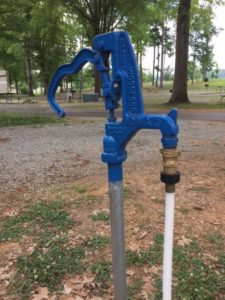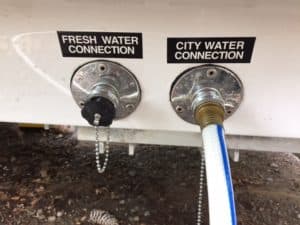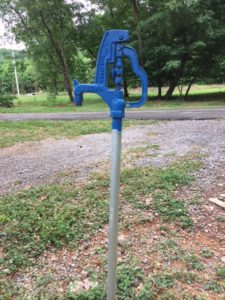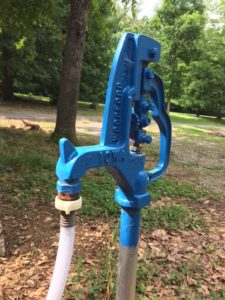Okay, if you know anything about RV water pressure regulators, you are probably rolling your eyes at this one. You might wonder how I can write an entire post about “installing” a water pressure regulator when, really, there is only a single step. Screw the regulator on to the end of your hose.
Fair enough. Still, this hack is worthy of a post because it comes with a story. Yep, the kind of story where I learn yet another lesson the hard way. Seriously, I’ll be glad when the day comes when I no longer have to say that. I anxiously await the day I report that I learned a lesson the easy way.
The Story
Before arriving at the David Crockett State Park, I’d been plugged in to four different water sources with no problems. So, I get to my spot and start the process of settling in which includes unhooking the trailer from the van and hooking the trailer up to the electric/sewer/water sources.
At the David Crockett State Park campground, there is only electric and water. No sewer. As I’ve done four times before, I attached one end of my water hose to the trailer and the other to the water source. In this case, a spigot rising about three feet out of the ground.
Then, I pulled the C-shaped handle all the way up to open the water. The water threaded through the hose and made its way into the rig. Then I heard a whoosh sound, like water exploding outward. It lasted only a few seconds, then it stopped.
I walked to the other side of the rig where the sound came from and water was dripping out from the compartment where the tankless water heater resides. Back to the spigot, I closed the water. I double checked all my connections.
I opened the water a second time. No bursting water sounds. Inside the rig, I tested both the kitchen and bathroom faucets. Everything seemed okay. So, I figured everything was okay. The sound I heard must’ve just been a fluke.
But about an hour later, my rig started growling. I don’t know how else to explain it. The sound, like before, came from the back curbside of the trailer, where the water heater lives. I went outside to investigate. Water was not dripping from the compartment. However, the inside of the compartment was wet. Then I discovered water dripping from the weep hole on the underside of the fiberglass.
Not knowing what to do and not wanting to make the problem worse, I turned off both the water and the water heater. Then I did what I always do when I get stuck. I wrote an email to Oliver. By the way, it was through this process I learned the term weep hole. In my email, I called it the “silver cuppy thing.”
The service manager has gotten quite a few emails from me since I picked up the trailer last October. He’s quick to reply, usually within a business day. It was late afternoon so it wasn’t likely I’d hear back that day.
And I didn’t. That night, I kept replaying the step-by-step of what happened and what I heard. I wanted to try to work it out for myself, if it was possible. So, I did as Winnie the Pooh, does…think, think, think.
Let me pause here to acknowledge that many of you might have diagnosed the problem right away. But my experience to that point with the same type of water source led me to not even consider the water source. After all, it worked four times previously.
I believed the problem was my rig. I felt strongly the problem had to do with my propane. “Apples and oranges,” you might be saying. But the only thing that was different between the setup at Davy Crockett State Park and the other times was that I pulled into Davy Crockett State Park with both propane tanks closed.
I hadn’t opened a tank before I hooked up the water. It’s not totally apples and orange since you do need the propane in order to heat the water in the water heater.
This might sound stupid. Maybe it is. But as I’ve said before, without any foundation in RVing, without ever having used propane before, without every having dealt with plumbing or electrical issues (aside from calling a repair person), I have no experience to draw on when trying to diagnose a problem.
And when you don’t know anything, every possibility is on the table. Even a propane problem when you find water in the water heater compartment.
If All Else Fails
You know what they say? If all else fails, read the manual?
My bad experience with condensation left me with the impression that the manual wasn’t ever going to be of much use. It certainly hadn’t been in that situation. But since nothing else occurred to me, I decided to give it a chance. In addition to the Oliver manual, I also have a manual for every component on the rig including the tankless water heater.
After review–it actually did help to read it–I concluded the problem probably had nothing to do with the propane and everything to do with water pressure. It was dark by then so trying to fix the newly-diagnosed problem had to wait.
Bright and early the next day, I dug through the trailer’s basement (that’s the outside storage area at the back of the rig above the two water source ports). Inside a tub labeled “Miscellaneous,” I found the brass water pressure regulator, still in the packing.
The brass water pressure regulator was included in the tools I received during my Oliver orientation. However, what my orientation didn’t include was the edict to put it on the end of my hose and never take it off.
I peeled the regulator out of the cardboard and plastic package, unscrewed the hose at the spigot, screwed the regulator to the end of the hose and then screwed the hose back into the spigot.
Moment of truth.
I tried to slowly open the water though it doesn’t really work that way. There is “off” until you get to “bursting-out-of-the-spout-on.” Still, I felt better going slow until the handle was all the way up and water flowing into my rig. No water bursting noise.

Hose with the water pressure regulator hooked up to the campground water source. The water source is fully open allowing water into the rig.
I turned it off again. Then went to the water heater and turned it on. And, because it couldn’t hurt, I opened one of the propane tanks.
For the final time, I opened the water. Still, no noises. No water dripping from the weep hole. And the inside of the water heater compartment was dry.
Inside the rig, I opened the water in the kitchen. It spit and sputtered but I didn’t panic because I’d seen that before. It’s caused by air in the line. I kept the tap open until the water ran smooth. I did the same in the bathroom.
Had I been hooked up to sewer, I would’ve let the water run for a while to really test everything. But since my gray tank was going to have to hold all my used water for the next four weeks, I shut the water off once it came out smooth.
I wrote a second email to Oliver, explaining my process and asked, “Does that sound like I fixed it?”
The short answer: “Yes.”
And he advised keeping the regulator on the hose at all times. No kidding.
It was such a huge relief that I didn’t break something And, even though it took several hours from start to finish, I was kind of proud of myself for diagnosing and fixing the problem. Who cares if the solution only had one step?
If you are an RVer, do you use a water pressure regulator?








Try YouTube for all problems. You’ll find everything there, and no waiting for email replies.
Good idea, Alison. I didn’t even think of that. Thanks!
Yes, we always use a regulator. I think we will also start using one also on the hose when we hook up to the spout that runs to the black tank too (for wash out). We’ve had to have the connection on the tank replaced already although I think it was a malfunctioned part rather than a blow out. We had hooked up to wash out the black tank (husband outside and me inside). He turned on the water source, no problem. But when I turned the valve to let the water run into the tank, it started spewing in the space beneath the dinette!! All is right with the world again now that it’s fixed ?
Did Jason say what happened with the water heater?
Thanks, Angela. Before we knew everything was fine, Jason said I might have cracked something that would mean it would leak water. I think the sound I heard was the water heater pushing out the excess and I just got really lucky that I all that pressure didn’t break something.
We use a pressure regulator. I learned it by reading about someone else’s experience learning it the hard way.
Do the Elite II’s have built in water filters? If not, you might want to consider one of those to hook to the camp spigot before you attach your hoses. They are those long blue cylinders that you see people using as you walk around the campgrounds.
I’ve got another tip for you. Buy a bunch of brass hose quick connects. Attach them to Quill and to all of your hoses. Soooooo much easier and faster. Plus the threads of the water connections on the camper will take less wear and tear. You can stack them in such a way on the camper connections that the plug covers still work. They will just quick connect back on. No screwing anything on anymore .
Here is a lesson I learned the hard way::::
I wanted to disinfect my freshwater tank. So I add just a touch of bleach to the hose and filled up the freshwater tank. Before long I noticed that water was pouring out by the steps! Thought I either broke it or it broke itself. Oh no! Come to find out, there is an overflow drain hole there. Lol. Be thankful that you have a manual! Hull #10 didn’t come with one of those! 😉
– Brandi
( JellyBean)
Yeah, the Oliver Elite II has a water filter built in. At least the 2017 did. I’ve been thinking though of getting a water filter for the hose, figuring that an extra chance to get gunk out of the water will mean having to clean the filter in the water heater less often. I haven’t heard of brass host quick connects, but now they are on my list. Sound very handy. Glad your lesson wasn’t costly. Those, of course, are the worse lessons of all. Hey did you know all of the manuals are on the Oliver website? Go to the very bottom and click on Oliver University. Now yours might be old enough that none of them help…but you never know. Thanks for the comment, Brandi.
I’ve checked the manuals online. You are right. They don’t help. Lol ?
Great information. And your story was lots of fun to read. I’ve never heard of a pressure regulator either. Thanks for saving me and our little trailer!
Thanks Karen. I figured you would already know about them. I’m glad I could help save someone else the headache.
Yes we use a water pressure regulator!! I know it felt good trouble shooting and figuring out the problem yourself!! ?
It did. Thanks. Practically a first, but I hope the first of more to come.
There is a water regulator in the basement of my RV. I’m glad now, that i know what to do with it.
You are such a big help with your blogs. My departure date is getting closer. 6/16
Becky Mueller
Indy
Glad I could be of help. Can’t wait to hear about your time at the animal sanctuary.
You say the 2017 models come with a water filter; my 2016 Oliver did not. My question: Are you sure? It seems to me that two filters would be needed, one for City Water and one for Fresh Water. If you do have a water filter, you should know were it is as they need to be replaced periodically.
I agree with Brandi about the brass hose quick connects. Makes the connections much easier. I keep one attached permanently to the City Water connection and one to the Fresh Water.
I had read on forums that people sometimes disconnect their hoses and then inadvertently leave the pressure regulator attached to the campground faucet. I came close to doing that several times, but I now have a good way to make that less likely. When I hook up, I put my hose wrap (in my case a large orange Nite Ize twist tie) onto the pressure regulator. That way when breaking camp I will remember the pressure regulator when, after coiling the water hose, I need the hose wrap.
Ok, David, now you are making me think. I feel like there was one already attached to both the City and Fresh water connections. But, at the same time, I have a memory of seeing a package with the little filter in it. You know my first stop after I pick up the trailer was an RV park where I had friends. And my friend completely hooked me up so it’s possible he attached the water filters to the rig connectors and I’ve just assumed they were there all along. And just today I was looking at the other packages I hadn’t opened in my basement and I have some quick connects. So at my next stop I’ll add those to the rig’s connections. Actually, it sounds kind of nice. I sometimes have had difficulty in getting my water connections untwisted from the hose so that might help. Great idea about the twist tie. Thanks for adding to the conversation!
You can eliminate the “spitting and sputtering” caused by air in the line by first hooking up your regulator and hose to the spout and then running water completely through your hose before connecting to the trailer. That eliminates the air in the hose and the spitting and sputtering which goes with it.
Was a water bandit also included in your orientation? This is a rubber and brass contraption where the rubber end can be attached to spigots which are not threaded. If you don’t have one, it could come in handy some day. They’re only a few bucks on Amazon.
Thanks Peter. You know when you said to let water run through the line, it made perfect sense. I just hadn’t ever thought of it like that since the sputtering happens at the sink, I assumed it was with the rig hoses. But of course it makes sense it would start at the hose. I didn’t get a water bandit with orientation, but it is now on my Amazon list. Thanks!
Thank you for the giggle! I think we use the pressure regulator … No matter, we definitely will from now on!
Your honesty is amazing and so helpful to others. Be well. Love, Marie
Thanks, Marie.
The story was a lot of funny. And I think the water pressure regulator primarily works by reducing the amount of water that gets through a pipe. Water forced through the pipes using extremely high pressure prior to the valve can be expected to slow down after the valve. It is a major help in ensuring that the pipes where the water passes through can lessen its risk of wear and tear. Is that right?
Hi Robert. Yep, you are exactly right. If you have too much pressure some of the components of your RV cannot take it and can break….like mine did. Lesson learned. At least the good news is that once I learned about water pressure regulators, they are a pretty inexpensive gadget that comes with tremendous peace of mind.
Yes, I have read in here: https://www.rvweb.net/best-rv-water-pressure-regulators-reviewed/#more-231 . There is many useful information.
Wow. I didn’t know there was so much to say on the subject. What a great find. Thanks for the article, Robert.